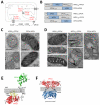Proteomic mapping of mitochondria in living cells via spatially restricted enzymatic tagging
- PMID: 23371551
- PMCID: PMC3916822
- DOI: 10.1126/science.1230593
Proteomic mapping of mitochondria in living cells via spatially restricted enzymatic tagging
Abstract
Microscopy and mass spectrometry (MS) are complementary techniques: The former provides spatiotemporal information in living cells, but only for a handful of recombinant proteins at a time, whereas the latter can detect thousands of endogenous proteins simultaneously, but only in lysed samples. Here, we introduce technology that combines these strengths by offering spatially and temporally resolved proteomic maps of endogenous proteins within living cells. Our method relies on a genetically targetable peroxidase enzyme that biotinylates nearby proteins, which are subsequently purified and identified by MS. We used this approach to identify 495 proteins within the human mitochondrial matrix, including 31 not previously linked to mitochondria. The labeling was exceptionally specific and distinguished between inner membrane proteins facing the matrix versus the intermembrane space (IMS). Several proteins previously thought to reside in the IMS or outer membrane, including protoporphyrinogen oxidase, were reassigned to the matrix by our proteomic data and confirmed by electron microscopy. The specificity of peroxidase-mediated proteomic mapping in live cells, combined with its ease of use, offers biologists a powerful tool for understanding the molecular composition of living cells.
Figures



Comment in
-
Proteomics: Marked for depth.Nat Methods. 2013 Apr;10(4):284. doi: 10.1038/nmeth.2427. Nat Methods. 2013. PMID: 23653924 No abstract available.
Similar articles
-
Directed evolution of APEX2 for electron microscopy and proximity labeling.Nat Methods. 2015 Jan;12(1):51-4. doi: 10.1038/nmeth.3179. Epub 2014 Nov 24. Nat Methods. 2015. PMID: 25419960 Free PMC article.
-
Proteomic mapping in live Drosophila tissues using an engineered ascorbate peroxidase.Proc Natl Acad Sci U S A. 2015 Sep 29;112(39):12093-8. doi: 10.1073/pnas.1515623112. Epub 2015 Sep 11. Proc Natl Acad Sci U S A. 2015. PMID: 26362788 Free PMC article.
-
Proteomic mapping of cytosol-facing outer mitochondrial and ER membranes in living human cells by proximity biotinylation.Elife. 2017 Apr 25;6:e24463. doi: 10.7554/eLife.24463. Elife. 2017. PMID: 28441135 Free PMC article.
-
Proteomic navigation using proximity-labeling.Methods. 2019 Jul 15;164-165:67-72. doi: 10.1016/j.ymeth.2019.03.028. Epub 2019 Apr 4. Methods. 2019. PMID: 30953756 Review.
-
Proximity labeling: spatially resolved proteomic mapping for neurobiology.Curr Opin Neurobiol. 2018 Jun;50:17-23. doi: 10.1016/j.conb.2017.10.015. Epub 2017 Nov 8. Curr Opin Neurobiol. 2018. PMID: 29125959 Free PMC article. Review.
Cited by
-
Mass-spectrometric exploration of proteome structure and function.Nature. 2016 Sep 15;537(7620):347-55. doi: 10.1038/nature19949. Nature. 2016. PMID: 27629641 Review.
-
ANGEL2 phosphatase activity is required for non-canonical mitochondrial RNA processing.Nat Commun. 2022 Sep 30;13(1):5750. doi: 10.1038/s41467-022-33368-9. Nat Commun. 2022. PMID: 36180430 Free PMC article.
-
GLAD: an Online Database of Gene List Annotation for Drosophila.J Genomics. 2015 Jul 1;3:75-81. doi: 10.7150/jgen.12863. eCollection 2015. J Genomics. 2015. PMID: 26157507 Free PMC article.
-
Heat-shock chaperone HSPB1 regulates cytoplasmic TDP-43 phase separation and liquid-to-gel transition.Nat Cell Biol. 2022 Sep;24(9):1378-1393. doi: 10.1038/s41556-022-00988-8. Epub 2022 Sep 8. Nat Cell Biol. 2022. PMID: 36075972 Free PMC article.
-
The tissue proteome in the multi-omic landscape of kidney disease.Nat Rev Nephrol. 2021 Mar;17(3):205-219. doi: 10.1038/s41581-020-00348-5. Epub 2020 Oct 7. Nat Rev Nephrol. 2021. PMID: 33028957 Review.
References
Publication types
MeSH terms
Substances
Grants and funding
LinkOut - more resources
Full Text Sources
Other Literature Sources
Research Materials

